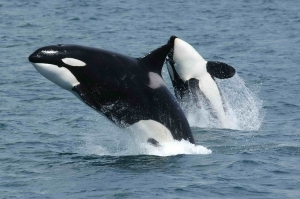Addressing barriers to development, deployment, and evaluation of marine hydrokinetic devices.
Sandia’s Water Power Technology program seeks to reduce the cost and time required to deploy marine hydrokinetic (MHK) devices. We utilize numerical modeling and experiments to develop solutions to the concerns and needs of both developers and regulators. Our work includes:
- Developing tools for identifying and mitigating environmental risks
- Providing data to accelerate permitting
- Creating professional development opportunities for developers and researchers
- Engaging in ocean planning to incorporate MHK technologies in the nation’s marine spatial plans
Predicting Environmental Effects
Regulators and developers have little information about the potential effects of MHK devices on aquatic environments. To address this problem, Sandia gathers hard-to-obtain data using predictive modeling, laboratory experiments, and field monitoring. We also conduct research to improve environmental monitoring tools and mitigation options. Our research enables developers to design devices and array configurations with optimal power production and minimal environmental impact.
Modeling Array Effects
 While studies show small numbers of MHK devices are unlikely to cause perceptible affects to physical aquatic environments, the potential effects of large arrays are still unknown. Sandia develops and refines numerical modeling methods to predict the effects of differing numbers and configurations of wave and current energy converters on water and sediment movement, water quality, and possible aquatic habitats. Data from these simulations allow developers to maximize power generation while minimizing negative environmental impacts.
While studies show small numbers of MHK devices are unlikely to cause perceptible affects to physical aquatic environments, the potential effects of large arrays are still unknown. Sandia develops and refines numerical modeling methods to predict the effects of differing numbers and configurations of wave and current energy converters on water and sediment movement, water quality, and possible aquatic habitats. Data from these simulations allow developers to maximize power generation while minimizing negative environmental impacts.
Acoustic Generation and Propagation Modeling

Sandia conducts acoustics tests in the water tunnel at the Applied Research Laboratory at Penn State.
Regulations prevent developers from deploying devices that generate enough noise to constitute disturbance to marine species. Because of the complex nature of acoustics modeling and the lack of measured data, meeting these requirements is a challenge for developers. Sandia has partnered with the Applied Research Laboratory at Penn State University to develop and validate open-source tools for modeling MHK noise generation and propagation. This free tool will make it easier for developers and regulators to determine the amount of noise created by a device and the potential effects of the noise on the environment.

Installation of the 1:8.7 scale rotor in the 1.22 m Garfield Thomas
Water Tunnel at Penn State University.
Noise Generation:
Sandia is investigating the use of CHAMP (Combined Hydro-Acoustic Modeling Program), a stochastic structural-analyses developed by Penn State University, to predict the radiated sound from an underwater turbine. To validate predictions, we developed a novel sub-scaled turbine which we tested in the Applied Research Laboratories’ 1.22m diameter water tunnel.
Noise Propagation:
Common methods for predicting the propagation of sound underwater are too limited to accurately predict the dissemination of noise from MHK devices. Sandia is developing Paracousti, a tool which will more accurately map sound propagation for individual turbines and turbine arrays. A 3-D, finite-difference solution to the governing velocity-pressure equations allows our tool to model spatially varying sound speeds, bathymetry, and bed composition, resulting in more accurate predictions.
Contact: Jesse Roberts – jdrober@sandia.gov
Strike Impacts to Sensitive Species
Sandia works with researchers from Pacific Northwest National Laboratory (PNNL) to determine the possible consequences of a marine mammal colliding with a tidal turbine. Sandia uses its high-power computational platforms to simulate impacts while PNNL performs biological assessments.
In 2014, this research removed barriers to the installation of the SNOPUD ducted turbine in Puget Sound. Regulators were concerned about a shrouded turbine installation harming the already endangered species. Using Sandia’s unique structural dynamics code, PRESTO, we simulated multiple scenarios in which a shrouded turbine struck a Southern Resident killer whale. PNNL used our simulations and data about the whale’s physical characteristics to assess the biological impacts of the strike. The results showed, even in the worst-case scenario with a full range of blade impact speeds, significant harmful damage to the whale’s tissue was unlikely. With this information, regulators were able to grant permits for the turbines installation.
Sandia and PNNL are now performing similar computational and biological assessments to determine the effects of a unducted turbine strike on a harbor seal.
Contact: Rich Jepsen – rajespe@sandia.gov




